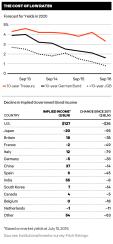We are living in an era of reduced expectations, and nowhere is that more true than the market for sovereign debt. Since March 2013, Institutional Investor has asked participants in its semiannual Country Credit survey to predict ten-year government bond yields in 2020 in the U.S., Germany and Japan. Since then, hopes of rate normalization in the U.S. have waned, while the European Central Bank and the Bank of Japan have gone negative. The result? Expectations for ten-year JGB yields have plunged from 2.7 percent three and a half years ago to just 0.8 percent in our latest survey, while the outlook for German Bunds has tumbled to 1.6 percent from 3.9 percent. Analysts remain more optimistic on the U.S. but still pared their 2020 estimate for ten-year Treasuries to 3.3 percent from 4.2 percent in March, reflecting the Federal Reserve’s refusal to raise rates since its initial hike last December.
The trend has been painful for pension funds and insurers. “It’s getting harder for those who have certain benchmarks or targets to reach those targets,” says Jonathan Lemco, a senior investment strategist at Vanguard Group.
According to Fitch Ratings, low and negative rates have slashed annual income generated by the world’s $38 trillion sovereign bond market by more than $500 billion over the past five years. Investors have responded by crowding into emerging market debt in a search for yield. The sector has seen record global inflows of more than $31 billion so far this year, including $14.8 billion in July, according to J.P. Morgan.

“As long as core rates remain where they are, they will support emerging market debt,” says Shahzad Hasan, an EM debt portfolio manager at Allianz Global Investors in London.
But higher EM rates often entail higher risk, notes Laura Sarlo, senior sovereign analyst at Loomis, Sayles & Co. Brazil’s government bonds currently yield around 12 percent, but recession and political turmoil pose big credit challenges, she says, adding, “It always behooves investors to be mindful of the credit risk they’re taking.” Although the survey forecasts for long-term yields have fallen, not all analysts have given up hope. “I have an expectation that we’re at the beginning stages of inflation ticking higher,” says Sarlo. If that’s the case, inflation risk premiums will rise and investors will demand more compensation, forcing bond yields higher.
“They’ll go back up again,” agrees Hasan. Still, he adds: “Every day you can open a newspaper and see all the analysts and portfolio managers that hate central banks. No one likes central bank policy, but it’s like the weather. What can you do about it?” •






